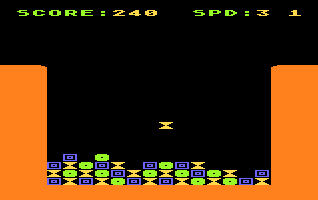Accidental Innovation, Part 1
In the mid-1980s I was writing 8-bit computer games. Looking back, it was the epitome of indie. I came up with the idea, worked out the design, drew the art, wrote the code, made the sound effects, all without any kind of collaboration or outside opinions. Then I'd send the finished game off to a magazine like ANALOG Computing or Antic, get a check for a few hundred dollars, and show up in print six months or a year later.
Where I got the ideas for those games is a good question. I was clearly influenced by frequent visits to arcades, but I also didn't just want to rip-off designs and write my own versions of the games I played there.
I remember seeing screenshots of some public domain games that appeared to have puzzle elements, though I never actually played them so I didn't know for sure. The puzzley aspects may have been entirely in my head. I had a flash of an idea about arranging objects so that no two of the same type could touch. Initially those objects were oranges, lemons, and limes, which made no sense, and there was still no gameplay mechanic. Somewhere in there I hit upon the idea of dropping the fruits in a pile and switched the theme to be about cans of radioactive waste that would hit critical mass if the same types were near each other for more than a moment.
Here's what I ended up with, designed and implemented in five days, start to finish: Uncle Henry's Nuclear Waste Dump.
At first glance, this may look like any of the dozens of post-Tetris puzzle games. There's a pit that you drop stuff into, and you move back and forth over the top if it. Stuff piles up at the bottom, and the primary gameplay is in deciding where to drop the next randomly-determined item. It's all very familiar, and except that the goal is reversed--to fill the pit instead preventing it from filling--there's nothing remarkable here.
Except that Tetris wasn't released in the United States until 1987 and Uncle Henry's Nuclear Waste Dump was published in 1986. I didn't even know what Tetris was until a few years later.
Was Uncle Henry's as good as Tetris? No. Not a chance. I missed the obvious idea of guiding each piece as it fell and instead used the heavy-handed mechanic of releasing the piece before a timer expired (that's the number in the upper right corner). And keeping three waste types separated wasn't nearly as addictive as fitting irregular shapes together. Overall the game wasn't what it could have been, and yet it's interesting that it's instantly recognizable as having elements of a genre that didn't exist at the time.
So close.
(While looking for the above screenshot, I found that someone wrote a clone in 2006. The part about the game ending when the pile gets too high sounds like the gameplay isn't exactly the same, but the countdown timer for dropping a can is still there.)
permalink February 19, 2011
previously
archives
I'm James Hague, a recovering programmer who has been designing video games since the 1980s. Programming Without Being Obsessed With Programming and Organizational Skills Beat Algorithmic Wizardry are good starting points. For the older stuff, try the 2012 Retrospective.
Where are the comments?
